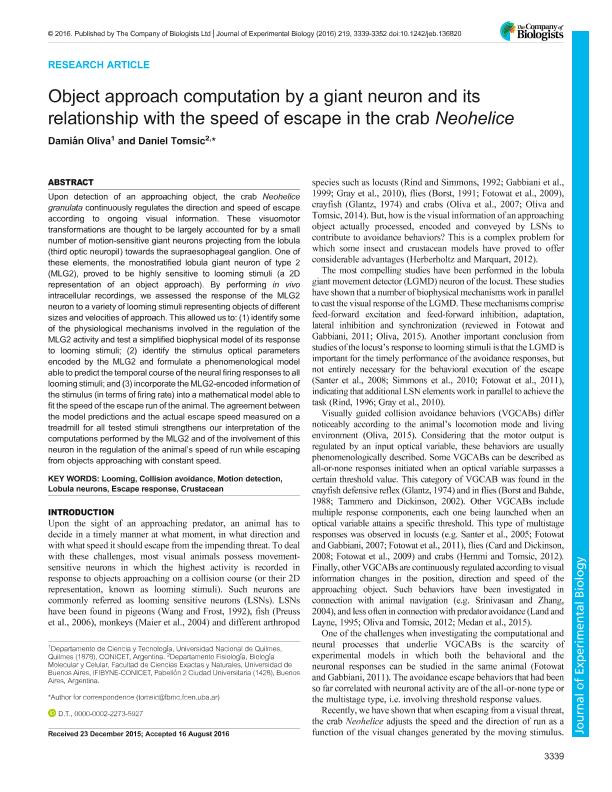Mostrar el registro sencillo del ítem
dc.contributor.author
Oliva, Damian Ernesto

dc.contributor.author
Tomsic, Daniel

dc.date.available
2018-05-30T13:45:39Z
dc.date.issued
2016-09
dc.identifier.citation
Oliva, Damian Ernesto; Tomsic, Daniel; Object approach computation by a giant neuron and its relation with the speed of escape in the crab Neohelice; Company of Biologists; Journal of Experimental Biology; 219; 9-2016; 3339-3352
dc.identifier.issn
0022-0949
dc.identifier.uri
http://hdl.handle.net/11336/46579
dc.description.abstract
Upon detection of an approaching object, the crab Neohelice granulata continuously regulates the direction and speed of escape according to ongoing visual information. These visuomotor transformations are thought to be largely accounted for by a small number of motion-sensitive giant neurons projecting from the lobula (third optic neuropil) towards the supraesophageal ganglion. One of these elements, the monostratified lobula giant neuron of type 2 (MLG2), proved to be highly sensitive to looming stimuli (a 2D representation of an object approach). By performing in vivo intracellular recordings, we assessed the response of the MLG2 neuron to a variety of looming stimuli representing objects of different sizes and velocities of approach. This allowed us to: (1) identify some of the physiological mechanisms involved in the regulation of the MLG2 activity and test a simplified biophysical model of its response to looming stimuli; (2) identify the stimulus optical parameters encoded by the MLG2 and formulate a phenomenological model able to predict the temporal course of the neural firing responses to all looming stimuli; and (3) incorporate the MLG2-encoded information of the stimulus (in terms of firing rate) into a mathematical model able to fit the speed of the escape run of the animal. The agreement between the model predictions and the actual escape speed measured on a treadmill for all tested stimuli strengthens our interpretation of the computations performed by the MLG2 and of the involvement of this neuron in the regulation of the animal's speed of run while escaping from objects approaching with constant speed.
dc.format
application/pdf
dc.language.iso
eng
dc.publisher
Company of Biologists

dc.rights
info:eu-repo/semantics/openAccess
dc.rights.uri
https://creativecommons.org/licenses/by-nc-sa/2.5/ar/
dc.subject
Vision
dc.subject
Collision Avoidance
dc.subject
Behaviour
dc.subject
Crab
dc.subject.classification
Otras Ciencias Biológicas

dc.subject.classification
Ciencias Biológicas

dc.subject.classification
CIENCIAS NATURALES Y EXACTAS

dc.title
Object approach computation by a giant neuron and its relation with the speed of escape in the crab Neohelice
dc.type
info:eu-repo/semantics/article
dc.type
info:ar-repo/semantics/artículo
dc.type
info:eu-repo/semantics/publishedVersion
dc.date.updated
2018-05-29T18:34:49Z
dc.journal.volume
219
dc.journal.pagination
3339-3352
dc.journal.pais
Reino Unido

dc.journal.ciudad
Cambridge
dc.description.fil
Fil: Oliva, Damian Ernesto. Universidad Nacional de Quilmes. Departamento de Ciencia y Tecnología; Argentina. Consejo Nacional de Investigaciones Científicas y Técnicas; Argentina
dc.description.fil
Fil: Tomsic, Daniel. Consejo Nacional de Investigaciones Científicas y Técnicas. Oficina de Coordinación Administrativa Ciudad Universitaria. Instituto de Fisiología, Biología Molecular y Neurociencias. Universidad de Buenos Aires. Facultad de Ciencias Exactas y Naturales. Instituto de Fisiología, Biología Molecular y Neurociencias; Argentina
dc.journal.title
Journal of Experimental Biology

dc.relation.alternativeid
info:eu-repo/semantics/altIdentifier/url/http://jeb.biologists.org/content/219/21/3339.abstract
dc.relation.alternativeid
info:eu-repo/semantics/altIdentifier/doi/http://dx.doi.org/10.1242/jeb.136820
Archivos asociados
